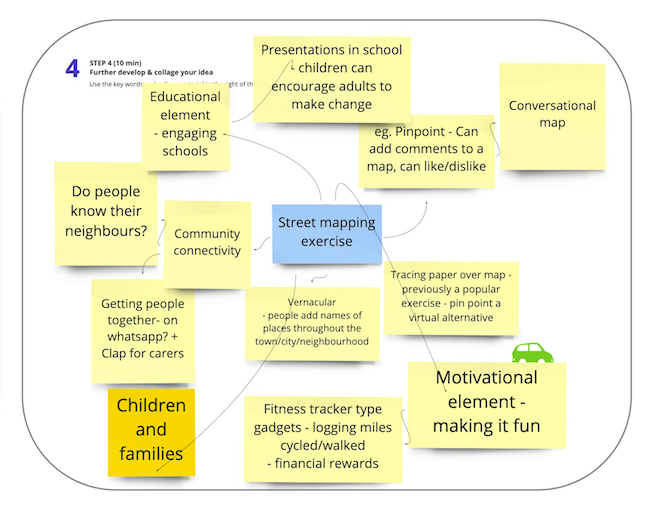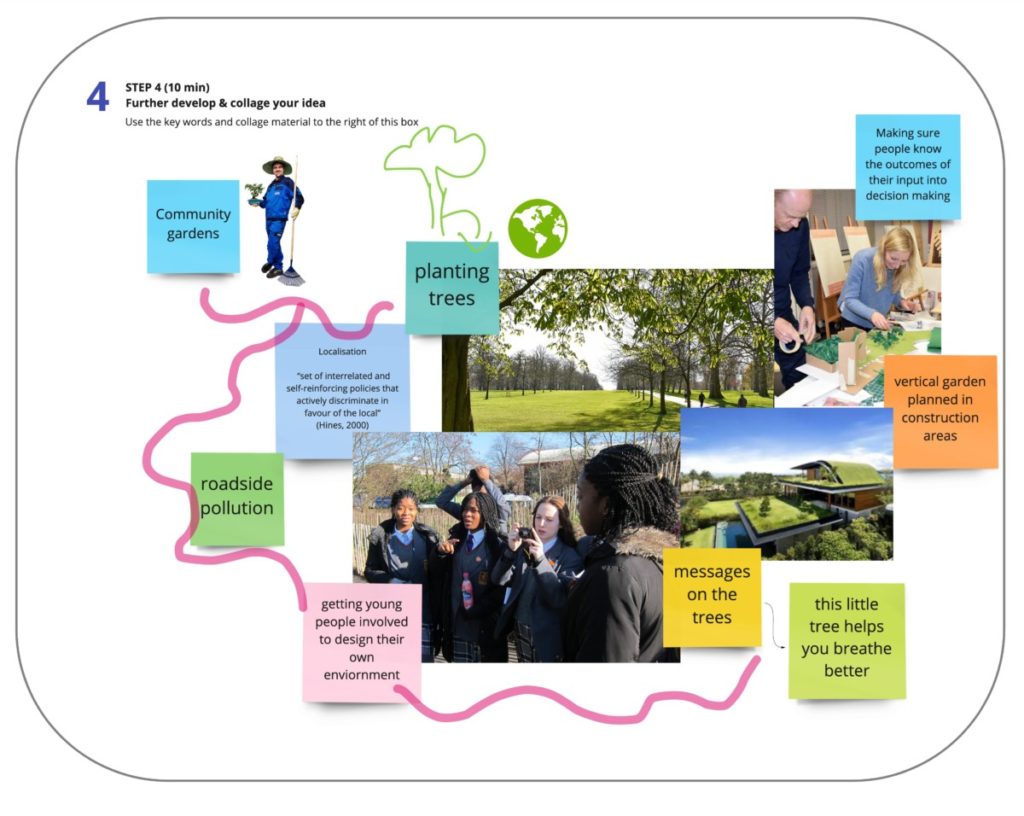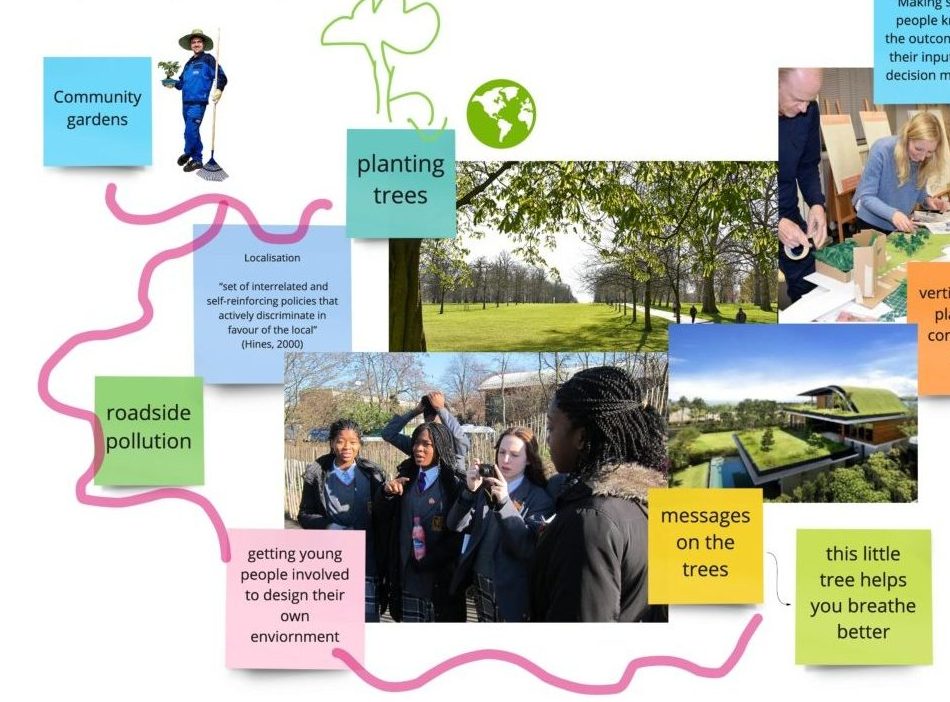Written by:
The Air We Share was the first event of our 2020/21 WEdesign event series, Co-designing Sustainable Places, in which we are exploring issues and co-design propositions for reshaping our neighbourhoods within the context of our climate emergency, the Covid-19 pandemic and place-based inequalities. This was one of our first public events held online, with the use of tools such as Zoom and Miro.
Using evaluation of ‘inclusion’ in LB Camden’s Clean Air Strategy as a frame for discussion, the event’s focus was to explore how to engage the public in informed decision-making and how policy-makers can use a range of participatory methods to involve citizens in shaping and activating public policy to tackle our climate emergency.
In collaboration with UCL, we devised a programme that covered introductions to the theme, policy and coinciding module work from Dr Lucy Natarajan, Lecturer at UCL and editor of the Built Environment Journal, and students from UCL Bartlett’s MSc in International Planning & MSc in Spatial Planning, who helped facilitate the event. Tom Parkes, Senior Air Quality Officer at LB Camden and joined the discussion.

Air Quality Research and Student Reflections
Lucy and a number of the attendees are passionate about air quality and are part of a collective dubbed Clean Air Community. The group is composed of scholars, staff and local residents in and around UCL estates. Building on the Great Ormond Street Hospital’s Clean Air Framework and UCL’s sustainability strategy, the group is exploring how to collectively promote clean air.
Reflecting on the strategy, the students noted that the most vulnerable groups to air pollution are the elderly, children and people with specific health conditions. However, during their research, students found the most active age group in terms of engagement (on the online platform) were 35-54-year-olds who may have family members or friends within the vulnerable groups.
They felt the Action Plan framework did support The Quadruple Helix Model of innovation which recognises four major actors in the innovation system: Civic organisations, citizens, industry, and academics. All these groups bring collaboration between four types of people, and they all bring knowledge and opinions to help develop different ideas. The students suggested that also finding new opportunities to reach more niche audiences would bring more diverse opinions and ideas to the table.
The students felt that bringing young people into the conversation is also key, especially as they are often harder to reach via traditional consultation methods. Producing engagement sessions in informal spaces where younger people like to congregate, such as youth centres, secondary and primary schools, would be ideal.
During the pandemic, digital engagement has become a hot topic. Students pointed to digital channels such as ‘Common Place’ and ‘Mapping for Change’, which they thought could be useful for consultation purposes, as users can pinpoint sites of concern. They also mentioned more straight-forward consultation tools and programs such as Built ID’s ‘Give My View’.
We also talked about virtual study tours. You can see an example of our digital study tour with a group from Broadwater Estate on our blog.
Co-design Activity
As this was an event to create space for discussion, collaboration and experimentation, we were then all keen to move into the more interactive part of the session. Sophia introduced the task in which event participants were divided into groups and each asked to create and co-design an engagement activity that activates local people and organisations to respond to one of the following objectives:
● Help raise awareness and educate people on sustainability
● Inform and respond to policy on place & sustainability
● Improve the quality and sustainability of development and retrofit
Social distancing also had to be considered and adhered to within their proposed activities.
Splitting off into break-out rooms, each set of attendees was accompanied by two students, one acting as a facilitator, and the other a reporter to help lead the task at hand. The digital whiteboard tool Miro was used so each group could create visuals and maps to help them illustrate their engagement activity ideas.
We were keen to move beyond traditional online event interactions to explore with participants how easily they could step into an active co-design space online using digital tools. Despite participants stepping into the challenge with differing levels of experience and confidence, these mixed groups of students, professionals, and community activists worked together to develop interesting and sophisticated propositions in a short space of time.
After the group work, we re-convened in our main virtual discussion space to hear each group present their idea(s).

Group Presentations of Ideas
The groups came up with a number of fantastic ideas, such as;
- Street mapping, using a map of the participants’ local area, to help with policy creation. The mapping process would also help participants connect with their neighbours and share ideas for the future of their area.
- Sending packs and letters to older people to inform them about clean air initiatives, as some groups may struggle with digital tools.
- Changing young people’s perceptions of policy and encouraging them to make a difference by using design to make policy more accessible and less daunting. For example visualising the future and associated policies.
- Utilising soundbites and QR codes to engage people from certain industries and to highlight the value of select physical spaces.
- Incentivising local businesses to connect and spread the message to the local public, through socially distanced events such as coffee mornings and gardening sessions.
- Growing initiatives led by community teams could enable young people to experience ownership of part of a green space and have a tangible impact on their local community.

Conclusion
During the course of the event, the conversation moved focus from Camden’s Clean Air Action Plan to a more general discussion about engaging and activating communities in driving forward the sustainability agenda. Many thrilling ideas were formed and attendees inspired by working and collaborating with a diverse group of people online.
We’d like to thank UCL, Lucy Natarajan, the student facilitators and all attendees for their participation and contribution.
“This was a really great event tonight co-designing & learning together to ensure that all parts of the community have their voices heard. Glad that I was part of the creativity!”
– Marco Zunino (UCL student) via Twitter
After this successful event, we’ll be following up with two more in the new year with our partners at the University of Sheffield and Glasgow School of Art. Please keep an eye on our events page for updates.

